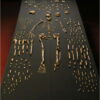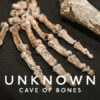The Rising Star cave, located in the Cradle of Humankind World Heritage Site in South Africa, is a karstic cave system situated in the Malmani dolomites near the Bloubank River valley. It covers an area of 250 × 150 m and consists of mapped passageways within a gently west dipping open fold. The cave is stratigraphically bound to a stromatolitic dolomite horizon in the lower parts of the Monte Christo Formation, which contains several thin chert marker horizons used to determine the position of chambers within the system.
Originally discovered by hobby cavers in the 1960s, the Rising Star cave gained significant attention in 2013 when a team of scientists led by Lee Berger unearthed a collection of fossils in the Dinaledi Chamber. These fossils, representing at least 15 individuals, were found in a narrow and challenging-to-reach space, requiring the development of a specialized technique called “vertical caving” for extraction.
Dating back between 3. and 2. million years, the fossils discovered in the Rising Star cave belong to a previously unknown species of hominin named Homo naledi. This small-bodied hominin exhibits a combination of primitive and derived features, such as a small brain like an ape, yet possessing traits associated with bipedalism, including long legs and a curved pelvis.
The discovery of Homo naledi in the Rising Star cave has provided valuable insights into the evolution of early hominins. It suggests a remarkable diversity among these species and the existence of complex behaviors like deliberate burial. As a significant site for human evolution, the Rising Star cave continues to offer important discoveries about our past.
The Rising Star cave holds great significance for several reasons. Firstly, it stands as one of the most abundant paleoanthropological sites globally, with over 1,550 hominin bones discovered so far, representing a minimum of 15 individuals. This extensive fossil collection provides valuable information about the evolution of early hominins.
Secondly, the fossils found in the Rising Star cave are exceptionally well-preserved due to the cave’s karstic environment, which has protected the bones from natural elements. Consequently, these fossils offer a detailed understanding of Homo naledi’s anatomy.
Thirdly, the Rising Star cave is noteworthy for providing evidence of deliberate burial. The fossils found in the tight space of the Dinaledi Chamber were intentionally arranged, indicating a complex understanding of death and the afterlife by Homo naledi. This marks the first evidence of deliberate burial at a hominin site.
In conclusion, the Rising Star cave plays a vital role in the study of human evolution, and its ongoing exploration promises further significant findings. The wealth of fossils discovered within the cave offers valuable insights into the evolution of early hominins, while the evidence of deliberate burial suggests that Homo naledi possessed a sophisticated and complex nature.






















